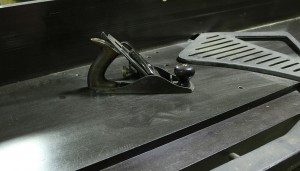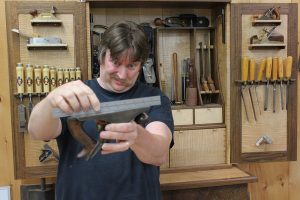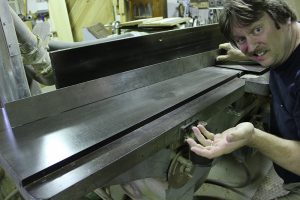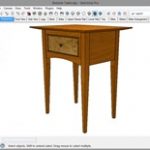We may receive a commission when you use our affiliate links. However, this does not impact our recommendations.
 Now that I’m officially on board I figure I’ll get the obligatory plane post out of the way early. Sure, I did my touchy-feely First Day post last week. And while I was in the PopWood offices (I’m back home in Penn. now until we make the final move) I got a chance to play around with Jet’s new 719200 lathe (read a little about it here) in order to review it for the October issue of the magazine. Now some would say those are “official” blog posts but I understand you are not “really” an editor until you’ve posted about planes.
Now that I’m officially on board I figure I’ll get the obligatory plane post out of the way early. Sure, I did my touchy-feely First Day post last week. And while I was in the PopWood offices (I’m back home in Penn. now until we make the final move) I got a chance to play around with Jet’s new 719200 lathe (read a little about it here) in order to review it for the October issue of the magazine. Now some would say those are “official” blog posts but I understand you are not “really” an editor until you’ve posted about planes.

For quite some time I’ve heard about lapping the sole of a plane in order to get it absolutely perfectly flat. Hogwash. Sure, flattening a plane can make life easier but it just isn’t a “necessity.” Those who think a plane is useless without being perfectly flat just don’t understand what a plane is or how it works, and they certainly don’t understand the tolerances of the medium in which we work. With all that said, I’ve never flattened a plane.
I’m a pretty meticulous woodworker but I only work to the nearest 1/32″. If my plane measures within that tolerance of being flat, I’m OK with it. I’ve always thought flattening planes is a waste of good woodworking time. If a plane is that far out of flat, throw it away and get another. If it’s an old plane, it just means someone abused it. If it’s new, it’s a defect.
 The biggest problem I have with flattening planes is, my plane of choice is just too big to flatten. From what I’ve read, people spend days flattening a simple smooth plane. How long is it going to take for me to lap this to perfection?
The biggest problem I have with flattening planes is, my plane of choice is just too big to flatten. From what I’ve read, people spend days flattening a simple smooth plane. How long is it going to take for me to lap this to perfection?
Whether your plane is hand or power, you really only need to know a few things. For a handplane, three points need to be in the same plane: the toe, the area right behind the mouth and somewhere toward the back of the plane. Honestly, you really can get away with two of those. The only one that has to remain is the spot right behind the mouth. It means you may have to learn how to apply pressure differently as you use the plane but it will still work. Sharp is far more important than flat. I don’t care what method you use to sharpen. Just pick the one that makes the most sense to you. Whether it’s a really old method of sharpening, mine or someone else’s, just sharpen.
For my plane of choice, I merely need to make sure my knives are parallel to my outfeed table and that my outfeed table is in line with the apex of the arc of the cutterhead. Once I achieve that, everything else is fairly inconsequential. Again, sharp is far more important than flat.
I may have oversimplified things a bit but it is my first “official” editorial post. One of the biggest problems I’ve seen with woodworkers over the years is, they worry the minutiae to death and don’t get to do what’s important: woodworking. Get into your shop, sharpen (because that’s far more important than flat) and set up your tools as quickly as possible and build something. If you do it often enough you’ll get better or you could spend all your time worrying about your plane being “a couple of thou” out of flat.
p.s. If you just can’t bear to replace an old handplane and would prefer to give it new life, check out Christopher Schwarz’s DVD “Super-Tune a Handplane: How to Turn a Flea-market Find into a Fast, Accurate and Smooth-cutting Tool.“
Here are some supplies and tools we find essential in our everyday work around the shop. We may receive a commission from sales referred by our links; however, we have carefully selected these products for their usefulness and quality.









Hi Chuck
Welcome to the organization!
Very welcome I should add.
We need all these kinds of viewpoints.
Thank you.
I don’t understand the emphasis on “behind the mouth.” Was that a typo? Or just applicable to the powered jointer? Certainly the area just ahead of the blade of a hand plane should be holding the workpiece down until the blade comes along to lift a shaving; otherwise the wood can split ahead of the cutting edge. Just look at the way a Japanese plane’s sole is configured, with the intermediate areas, including that following the blade (OK, so Japanese woodworkers use what we would consider backward terminology, referencing it to the body of the user rather than direction of travel) are slightly relieved to minimize contact friction, eliminate unnecessary flattening tedium, as well as controlling the cutting process. In my experience, whether from faulty manufacture or age-warping, the area following the blade of an old (occasionally new) metal-bodied plane can be lower than the front edge of the mouth, requiring the blade to be extended too far for proper control of the cutting. For more on this, see pages 151 and 160 of Scott Wynn’s “Woodworker’s Guide to Handplanes.”
Chuck, you are so right, and not alone in your thinking. Here’s the Ron’s Remarks column from Ron Herman’s May e-newsletter:
FLATTENING THE SOLES OF BENCH PLANES
I talk to a lot of students who are convinced the only way a bench plane can be useful is for the sole to be completely flat. They invest a lot of time and money to grind those soles to insane engineering tolerances, when It’s not necessary at all. These cast planes were never even sent from the factory utterly flat!
For the plane to work properly, the toe, heel and mouth behind the blade must be flat in a geometric plane in regard to each other. That’s it. That is where it is important for them to contact the wood. For evidence of this, look at corrugated planes. How could they possibly work – and they do – if they had to be completely flat with complete contact?
Complete contact causes friction and may add drag to your stroke, causing you to work harder for the same effect. Do yourself a favor and stop flattening the sole when those three areas are flat, and use the rest of your time to make more shavings.
– Ron
PS – We recently fettled up some garage sale planes with our students and flattened the soles in this manner. They were shaving .001″ rivings in short order!
“For a handplane, three points need to be in the same plane: the toe, the area right behind the mouth and somewhere toward the back of the plane.”
Don’t know about others, but when I hear about someone flattening a plane sole, the _whole point_ of the exercise is to ensure that the above is true.
I don’t know of a lot of people that lap till the entire sole is flat.
Chuck I know what you’re thinking, ’cause right now I’m thinking the same thing. Actually, I’ve been thinking it ever since I got here: Why oh why didn’t I take the BLUE pill?
Wow, I just renewed my subscription today! Might be worth it just for the entertainment value!!
I like what you are saying Chuck.
Don’t let those who disagree with you influence your stance.
I’ve been a fan of your work for a long time.
I think you know what works and what doesn’t.
Thanks
Eric
I love it and I’m with you. But be careful, I understand that Christopher Schwarz has super sharpened his No. 8, flattened the sole to 0.00000001 in and he’s gunning for you.
A couple of things I’ve found out: Sharp trumps flat everyday of the week; there is no such thing as a perfectly flat hand plane; the board will tell you how flat it is, not the plane; sole flatness has nothing to do with creating a good glue edge which is the real job of a jointer; if your stock is so rough that you need to spend hours flattening it, find a place that has better stock.
‘I know you’re out there… I know that you’re afraid. You’re afraid of change…I don’t know the future…I didn’t come here to tell you how this is going to end, I came here to tell you how this is going to begin. Now, I’m going to stop replying to this post and I’m going to show these people what you don’t want them to see. I’m going to show them a woodworking world without rules and controls, without borders or boundaries. A woodworking world…where anything is possible.’
I just spray a coat of this stuff on and it is flat
http://www.yachtpaint.com/usa/diy/products/finishes/flattening-agent-for-1-part-finishes.aspx
I am real sorry for Chuck.
His tennons don’t fit. Very few glues fill gaps of 1/32 inch.
He can’t plane a flat surface because of the hollow in his plane. His doors and drawers don’t fit.
I could, but will not, go on for hours about his mistaken and missleading attitude to accuracy and tolerances.
Please do not continue with this ludicrous heresy. ( I’d much prefer a rude word beginning with B).
best wishes
David Charlesworth
Looks like Chuck’s advice on what is important for a “plane” is based on a powered “plane” with rotating knives/irons for which the depth of cut is adjusted by raising or lowering the portion of the sole ahead of the knives, aka in-feed table, relative to the knives and portion of the sole behind the knives, aka out-feed table; what is frequently called a powered joiner. It looks like good advice for that type of “plane”.
Not such good advice for a “plane” with a non-rotating iron/knife for which the depth of cut is adjusted by raising or lowering the iron/knife relative to the entire sole, ie both the in-feed and out-feed tables; what is commonly called a hand plane. If the sole is worn excessively just ahead of the mouth compared to behind the mouth the plane won’t behave properly.
Soles of hand planes do not need to be “perfectly” flat, and Japanese hand planes demonstrate that. But they need to be close enough to flat in the right places, and the right places need to be close enough to planar with each other. How close is “close enough” depends on how the plane needs to perform, the wood being planed, etc.
Chuck, I don’t believe that you “only work to the nearest 1/32″.” I’ve watched you cut dovetails and your saw cuts are considerably closer than “the nearest 1/32″.” And I suspect if you are jointing the edges of boards for a glue joint you won’t tolerate a 1/32″ gap at the ends of the joint. Perhaps what you mean is that you “dimension” to the nearest 1/32″ but you fit joints to much finer accuracy.
I have a very nice old #3 size plane which just wouldn’t work right when I acquired it. With the iron adjusted for a reasonable shaving in the middle of a board, it would grab and try to take too wide when starting with just the toe on the board. If I retracted the iron so it didn’t grab when starting, it was too far retracted to cut the wood with the full length of the plane on the board, Turns out the sole was worn concave, particularly in front of the mouth. I didn’t measure how much it was worn but it was certainly less than 1/32″; probably around 10-thousands or so. Less than hour or so with a granite plate and some 80 grit sandpaper and the sole is flat enough for the plane to work very nicely. I don’t know exactly how flat the sole is though.
Welcome Chuck! It’s good to hear yet another voice of sense and sensibility joining the fray.
At last a new voice of reason in the wilderness. Now please don’t start selling off all of your “excess” tools.
Don’t get me wrong the Schwarz is one of my favorites. I just like all of my tools….. and books.
Well Mr Chuck,
At least you’re not scared to stir the pot a bit.
I disagree, but only because I’m older, obstinate, and in all honesty a contrarian…
Best regards,
Albert A Rasch
Merrily dodging 107s at FOB Shank Afghanistan
Way to lob the hand grenades. 🙂 But just one question… what’s more important, sharp or flat? 😉
I’m looking forward to more Chuck!
Music to my ears. Keep it up Chuck.
AMEN! Now if we can only get past building shop furniture. 🙂
Back of the mouth? Are you sure you don’t mean the front?
When my wooden smoothing plane refuses to take thin shavings it usually means the sole isn’t flat anymore (“flat” as in the toe, the front of the mouth and the heel being coplanar). Usually a bulge has formed at the back of the mouth, thus raising the front of the mouth off the wood. That makes adjusting the iron to a thin shaving very difficult.
Amen Chuck! Good to see you on board with Popwood!
I’ll admit it. I’ve never understood the point of feeler gauges in a woodshop. I see power tool reviews that judge the flatness of a tablesaw to the thousandths of an inch. Or jointer fences.
We’re working in a medium that moves more than that if it happens to be raining that day.
Am I missing something here?
Challenging closely held religious dogma within your first month? This could prove interesting.
Good luck and keep up the good fight.
Yes. That was some kind of beautiful. Needed said.